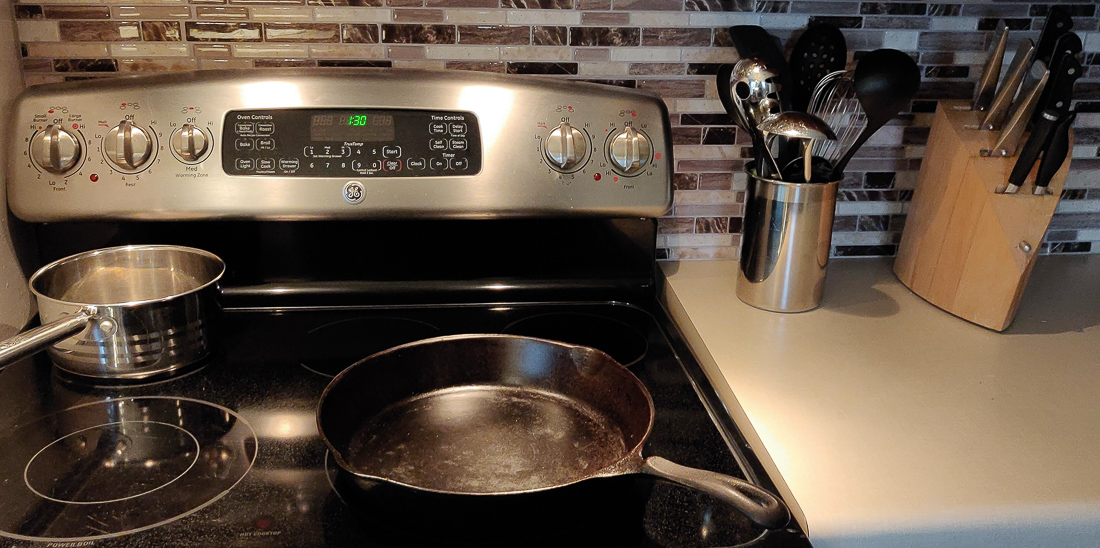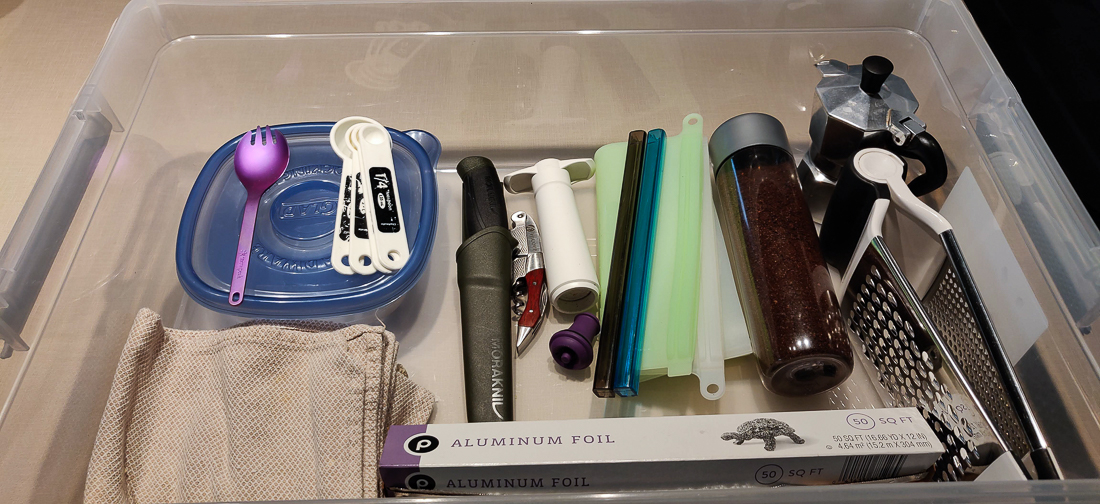
One of the biggest hurdles as perpetual travelers is how to eat healthy and economically while on the road. Plus, for us, our food needs to genuinely taste good too. How do we accomplish this while constantly traveling? The best way is to cook our own food.
Of course, simple spaghetti with jar sauce, frozen pizzas, and box mac-n-cheese are fine once in a while, but I’m not a 10-year-old, and my body does not respond well to heavy doses of carbs (i.e. I expand rapidly in the mid latitudes.) But eating salads, carrot sticks, and nuts everyday makes me jittery like a squirrel constantly on the lookout for something that truly addresses my hunger. Sustaining a varied menu of reasonably healthy and tasty dishes depends on the spices and sauces you have available. Without them in our mostly vegetarian world, you best get used to a steamed vegetables over quinoa vibe.
If you are traveling in an RV, problem solved as you can store all your favorites spices and ingredients, plus you are carrying a refrigerator around with you. As non-RV owning slow travelers, we are limited on space but do have the benefit of staying for a month or two in homes with a stove, oven, and refrigerator. The downside is that you are never sure what will be available in said kitchen when you arrive. Sometimes, there is a large spice rack and variety of cooking oils. Often, there are only salt & pepper shakers, ketchup packets, and some corn-based oil of indeterminate age. Therefore, we get creative to make our diets work.
I define “core” as food items we always have on hand. If we run out, we go get more. Since they are always with us, we try packing them as efficiently as possible.
Spices: small resealable bags with labels, all stored in large resealable bag
Coffee / Tea: stored in compact airtight containers
Olive Oil: only bottles that fit in our travel food tupper
Baking Stuffs: I love to bake and it is very economical, so we almost always have some baking ingredients on hand (flour, baking powder, baking soda, cornmeal, sugar)
Cold condiments: Mayo, mustard, soy sauce
Nomad jumble: packets of ketchup/sweetener/honey/hot sauce, toothpicks…
“Non-core” items are things that we pick up along the way and would take from place to place if we have them on hand. However, if space is tight we either ditch them before moving on or don’t replace them when we run out. Examples include Asian fish sauce, red chili curry, cornstarch, relish, Worcestershire Sauce, brown sugar, vegetable stock, cereal, pasta, rice, and hard cheeses such as parmesan.
All perishable or flat-out heavy items are bought upon arrival at the next long-term location. These include milk, bread, vegetables, fruit, canned items, meats, and tofu.
Since we like to spend at least a month in most places, we have established a standard process for cooking. Here is how we organize cooking on the road.
Day after arrival: Go to the local market, resupplying non-core perishables and gathering components for the next 3 main meals.
Week 1 – 4: Karen and I rotate planning and cooking 3 main meals at a time. Our menus endeavor to use as many on hand ingredients as possible. We’ll often eat out once a week on a non-cooking day.
Final week: Our menu focuses mainly on using up the food we have on-hand as much as possible. That way, we don’t have transport as much to next place. As a result, the recipes we make tend to be creative and somewhat custom. If we finish off something early, say the milk, then we hit the coffee shop or bakery for breakfast instead of buying more. It’s a huge sacrifice, I know.
Day before departure: No Cooking – we are packing up and getting ready to go. We either eat out, finish off leftovers, or have a ready-made meal like a frozen pizza.
Travel Day(s): All dried and package goods go into a large square tupper. The refrigerated items go into a cold bag with Cooler Shock cold packs. Those ice packs will keep food cold for days if needed.
While the food part of cooking on the road is admittedly somewhat important, don’t sleep on your cooking implements. Again, we never know what we will find when we show up to our new home. Admit it, you do the same thing when you arrive at your Airbnb or VRBO vacation home.
First, you check if the bed is a luscious pillow top or something more medieval. Next, you go straight to the kitchen, opening all cabinets and drawers to see what goodies you find. It can be like Christmas on move-in day. Ah, the splendor of finding crock pots, saucepans, mixing bowls, wooden spoons, casserole dishes, spatulas, or a cast iron skillet.

Alas, it is often more like finding an orange and an assortment of nuts in your stocking. You will be able to feed yourself, but it will not be particularly easy or fun. Now, virtually all places will have the basics: pot, pan, knife, can opener, big spoon, serving dishes, utensils, and coffee maker. However, we have found carrying the following items can salvage even the most utilitarian of kitchens.
Measuring spoons: it’s kind of a pain when the only measuring spoon you find is a tsp
Camp knife: all too often the knives that come with the rental have the cutting edge of a toothbrush
Silicon Sealable Bags: a great option for refrigerator / freezer storage, and they pack down easily
Tupperware: a couple of small containers come in handy for leftovers
Bialetti Coffee Pot / milk frother: I’m a coffee snob, I can live with that
Hand towels: there’s almost never enough kitchen towels. The cleanup crew will thank you endlessly
Cheese grater: Karen insisted since most graters require a knuckle sacrifice to use
Tin foil: extremely handy in oh so many ways

A full-time traveler is always balancing between “do I need it?” versus “do I want to be hauling it all over creation?”. Remember, every month you have to pack it all up, transport it, and then unpack it again. Keeping cooking items economical and as light as possible is in your best interest. With a little planning and organizing, you too can enjoy tasty and healthy meals on the road.
Leave a Reply